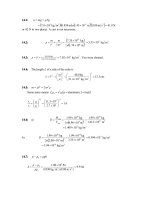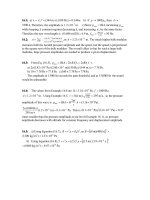- Trang chủ >>
- Khoa Học Tự Nhiên >>
- Vật lý
Tài liệu Physics exercises_solution: Chapter 15 pdf
Bạn đang xem bản rút gọn của tài liệu. Xem và tải ngay bản đầy đủ của tài liệu tại đây (516.22 KB, 39 trang )
15.1: a) The period is twice the time to go from one extreme to the other, and
sm1.2or s,m20.1s)(5.0m)00.6( Tfv
to two figures. b) The amplitude
is half the total vertical distance,
m.310.0
c) The amplitude does not affect the wave
speed; the new amplitude is
m.150.0
d) For the waves to exist, the water level cannot be
level (horizontal), and the boat would tend to move along a wave toward the lower level,
alternately in the direction of and opposed to the direction of the wave motion.
15.2:
vf
Hz105.1
m001.0
sm1500
6
v
f
15.3: a)
m.0.439Hz)(784s)m344( fv
b)
Hz.105.25m)10(6.55s)m344(
65
vf
15.4: Denoting the speed of light by c,
,
f
c
and
a)
m.87.2b).m556
Hz105.104
sm1000.3
Hz10540
sm10003
6
8
3
8
.
15.5: a)
Hz)000,20(s)m344(m,17.2Hz)0.20()sm344(
minmax
cm.72.1
b)
mm.74.0Hz)000,20(s)m1480(m,74.0Hz)0.20()sm1480(
minmax
15.6: Comparison with Eq. (15.4) gives a)
mm,50.6 cm,0.28b)
Hz8.27c)
s0360.0
11
T
f
and from Eq. (15.1), d)
sm7.78Hz)m)(27.8280.0( v
,
direction.e) x
15.7: a)
Hz,25.0m)320.0(s)m00.8( vf
m.rad19.6m)320.0()2(2s,104.00Hz)0.25(11
2
ππkfT
b)
.
m320.0
Hz)(25.02cosm)0700.0(),(
x
t
πtxy
c)
cm.95.4m))(0.320m)(0.360Hz)s)(25.0((0.1502cosm)0700.0( π
d) The argument in the square brackets in the expression used in part (c) is
),875.4(2π
and the displacement will next be zero when the argument is
;10π
the time is then
s0.1550m))(0.320m)(0.360Hz)(50.251()5( xT
and the elapsed time is
s.02.02e) s,0050.0 T
15.8: a)
b)
15.9: a)
)cos()sin(
2
2
2
ωtkxAk
x
y
ωtkxAk
x
y
),cos()(sin
2
2
2
ωtkxAω
t
y
ωtkxAω
t
y
and so
),(and,
2
2
2
2
2
2
txy
t
y
ω
k
x
y
is a solution of Eq. (15.12) with
.kωv
b)
)sin()cos(
2
2
2
ωtkxAk
x
y
ωtkxAk
x
y
),(sin)cos(
2
2
2
ωtkxAω
t
y
ωtkxAω
t
y
and so
),(and,
2
2
2
2
2
2
txy
t
y
ω
k
x
y
is a solution of Eq. (15.12) with
.kωv
c) Both waves
are moving in the
x
-direction, as explained in the discussion preceding Eq. (15.8).
d) Taking derivatives yields
.)(sin),(and)(cos),(
2
ωtkxAωtxaωtkxωAtxv
yy
15.10: a) The relevant expressions are
)cos(),( tωkxAtxy
)(sin ωtkxωA
t
y
v
y
).(cos
2
2
2
kxωtAω
t
v
t
y
a
y
y
b) (Take A, k and
ω
to be positive. At
,0t
x
the wave is represented by (19.7(a)); point
(i) in the problem corresponds to the origin, and points (ii)-(vii) correspond to the points
in the figure labeled 1-7.) (i)
,)0cos( ωAωAv
y
and the particle is moving upward (in
the positive y-direction).
,0)0sin(
2
Aωa
y
and the particle is instantaneously not
accelerating. (ii)
,2)4cos( ωAπωAv
y
and the particle is moving up.
,2)4sin(
22
AωπAωa
y
and the particle is speeding up.
(iii)
,0)2cos( πωAv
y
and the particle is instantaneously at rest.
,)2sin(
22
AωπAωa
y
and the particle is speeding up.
(iv)
,2)43cos( ωAπωAv
y
and the particle is moving down.
,2)43sin(
22
AωπAωa
y
and the particle is slowing down (
y
v
is becoming less
negative). (v)
ωAπωAv
y
)cos(
and the particle is moving down.
,0)sin(
2
πAωa
y
and the particle is instantaneously not accelerating.
(vi)
2)45cos( ωAπωAv
y
and the particle is moving down.
2)45sin(
22
AωπAωa
y
and the particle is speeding up (
y
v
and
y
a
have the
same sign). (vii)
,0)23cos( πωAv
y
and the particle is instantaneously at rest.
AωπAωa
y
22
)23sin(
and the particle is speeding up.
(viii)
,2)47cos( ωAπωAv
y
and the particle is moving upward.
2)47sin(
22
AωπAωa
y
and the particle is slowing down (
y
v
and
y
a
have
opposite signs).
15.11: Reading from the graph, a)
s.040.0b) ,mm0.4 TA
c) A displacement of
0.090 m corresponds to a time interval of 0.025 s; that is, the part of the wave represented
by the point where the red curve crosses the origin corresponds to the point where the
blue curve crosses the t-axis
)0( y
at
s,025.0t
and in this time the wave has traveled
0.090 m, and so the wave speed is
sm6.3
and the wavelength is
m14.0)s040.0)(sm6.3( vT
. d)
sm6.0s0.015m090.0
and the wavelength is
0.24 m. d) No; there could be many wavelengths between the places where
)(ty
is
measured.
15.12: a)
t
T
x
π
A
T
tx
πA
2
cos2cos
,
2
cos
vtxA
where
vf
T
has been used.
b)
.
λ
2
sin
λ
2
vtx
π
A
πv
t
y
v
y
c) The speed is the greatest when the cosine is 1, and that speed is
λ2πvA
. This will be
equal to
v
if
πA 2
, less than v if
πA 2
and greater than
v
if
πA 2
.
15.13: a)
:0t
____________________________________________________________
x(cm) 0.00 1.50 3.00 4.50 6.00 7.50 9.00 10.50 12.00
____________________________________________________________
y(cm) 0.000 0.212 0.300 0.212 0.000 0.212 0.300 0.212 0.000
____________________________________________________________
b) i) t = 0.400 s:
_______________________________________________________________
x(cm) 0.00 1.50 3.00 4.50 6.00 7.50 9.00 10.50 12.00
_______________________________________________________________
y(cm) 0.285 0.136 0.093 0.267 0.285 0.136 0.093 0.267 0.285
_______________________________________________________________
:s800.0ii t
________________________________________________________________
x(cm) 0.00 1.50 3.00 4.50 6.00 7.50 9.00 10.50 12.00
________________________________________________________________
y(cm) 0.176 0.296 0.243 0.047 0.176 0.296 0.243 0.047 0.176
________________________________________________________________
15.14: Solving Eq. (15.13) for the force
,F
.2.43))m750.0()Hz0.40((
m2.50
kg120.0
2
2
2
fμμvF
15.15: a) Neglecting the mass of the string, the tension in the string is the weight of
the pulley, and the speed of a transverse wave on the string is
s.m3.16
)mkg0550.0(
)sm80.9)(kg50.1(
2
μ
F
v
b)
m.136.0)Hz120()sm3.16( fv
c) The speed is proportional to
the square root of the tension, and hence to the square root of the suspended mass; the
answers change by a factor of
m.0.192andsm23.1 to,2
15.16: a)
s.m8.41)kg800.0()m0.10()0.140( μFv
b)
m.9.34)Hz20.1()sm8.41( fv
c) The speed is larger by a factor of
,2
and so for the same wavelength, the frequency must be multiplied by
Hz.1.70or ,2
15.17: Denoting the suspended mass by
M
and the string mass by
,m
the time for the
pulse to reach the other end is
s.390.0
)sm80.9)(kg50.7(
)m0.14)(kg800.0(
)(
2
Mg
mL
LmMg
L
v
L
t
15.18: a) The tension at the bottom of the rope is due to the weight of the load, and
the speed is the same
sm5.88
as found in Example 15.4 b) The tension at the middle
of the rope is (21.0
N8.205)sm809()kg
2
.
(keeping an extra figure) and the speed of
the rope is
s.m7.90
c) The tension at the top of the rope
is
sm6.215)sm80.9)(kg0.22(
2
and the speed is
.sm9.92
(See Challenge Problem
(15.80) for the effects of varying tension on the time it takes to send signals.)
15.19: a)
sm0.10)mkg(0.0500N)00.5( μFv
b)
m0.250Hz)(40.0)sm(10.0 fv
c)
)specified.as,)0.0(:(Note)cos(),( AyωtkxAtxy
srad0.802 m;rad00.82 ππfωππk
-
])srad0.80()mrad(8.00cos[)cm00.3(),( tπxπtxy
d)
)cos(and)sin(
2
ωtkxAωaωtkxAωv
yy
222
max,
sm1890)(2 πfAAωa
y
e)
is
max,y
a
much larger than g, so ok to ignore gravity.
15.20: a) Using Eq.(15.25),
22
ave
2
1
AωμFP
232
3
)m106.1())Hz0.120(2()N0.25(
m0.80
kg1000.3
2
1
= 0.223 W,
or 0.22 W to two figures. b) Halving the amplitude quarters the average power, to 0.056
W.
15.21: Fig. 15.13 plots
0.at )(sin),(
222
xωtkxAωμFtxP
)(sin)(sin),(0,For
2
max
222
ωtPωtAωμFtxPx
When
.2)4()2(,4 ππkxx
sin
ωtPtPωtωtπ cos),4(so,cos)2(
2
max
The graph is shifted by
4T
but is otherwise the same. The instantaneous power
is still never negative and
0.at assame the,
max
2
1
av
xPP
15.22:
m,5.2)m5.7(
2
2
2
1
mW0.1
mW11.0
12
Ι
Ι
rr
so it is possible to
move
m5.0m5.2m5.7
21
rr
closer to the source.
15.23: a)
2
22
2
11
rΙrΙ
2222
2112
mW050.0)m3.1m3.4)(mW026.0()( rrΙΙ
b)
W04.6)mW026.0()m3.4(44
222
πΙπrP
Energy =
J102.2)s3600)(W04.6(
4
Pt
15.24: (a)
Hz.118(b)mm.30.2
2
srad742
2
π
ω
fA
(c)
m.90.0
mrad98.6
22
k
π
(d)
s.m106
mrad98.6
srad742
k
ω
v
(e) The wave is traveling in the –x direction because the
phase of y (x,t) has the form
.ωtkx
(f) The linear mass density is
mkg10504.2)m35.1()kg1038.3(
33
μ
, so the tension is
N3.28)sm3.106)(mkg10504.2(
232
μvF
(keeping an extra figure in
v
for
accuracy).
23
2
1
22
2
1
av
)srad742()N3.28)(mkg1050.2()g(
AωμFP
W.39.0)m1030.2(
23
15.25:
m15.0at mW250.0
2
rI
W707)mW250.0()m0.15(44
222
πIπrP
15.26: a) The wave form for the given times, respectively, is shown.
b)
15.27: a) The wave form for the given times, respectively, is shown.
b)
15.28:
15.29:
15.30: Let the wave traveling in the
t).(cos),(bedirection
1
ωkxAtxyx
The
wave traveling in the
x
direction is inverted due to reflection from the fixed end of the
string at
).cos(),(form thehasit so,0
2
ωtkxAtxyx
The wave function of the
resulting standing wave is then
),(),(),(
21
txytxytxy
, where
vωkπTπωA s,rad1072.1s)1065.3(22mm,46.2
33
m.rad5.15)sm111)(srad1072.1(
3
15.31: a) The nodes correspond to the places where
integeran ,or 0sin is, that );1.15(Eq.in allfor 0
nodenode
nnπkxkxty
.
nxπk m)333.1( m,rad75.0With
node
and for
m,...6.67m,5.33m,4.00m,2.67m,1.333,0...,,2,1,0
node
xn
b) The antinodes
correspond to the points where cos
,0kx
which are halfway between any two adjacent
nodes, at 0.667 m, 2.00 m, 3.33 m, 4.67 m, 6.00 m, ...
15.32: a)
,sinsin
sw
2
2
2
kxωtAk
x
y
,sinsin
sw
2
2
2
kxωtAω
t
y
so for
),( txy
to be a solution of Eq. (15.12),
,
2
2
2
v
ω
k
and
.
k
ω
v
b) A standing wave is built up by the superposition of traveling waves, to which the
relationship
kωv
applies.
15.33: a) The amplitude of the standing wave is
cm,85.0
sw
A
the wavelength is
twice the distance between adjacent antinodes, and so Eq. (15.28) is
).cm0.302sin())s0.0752sin(()cm85.0(),( πxtπtxy
c)
cm.688.0))cm0.30(cm)(10.52sin()cm0.850( π
m/s.00.4)s0750.0()cm30.0(λλb) Tfv
15.34:
)]cos()cos([
21
ωtkxωtkxAyy
]sinsincoscossinsincoscos[ ωtkxωtkxωtkxωtkxA
.sinsin2 ωtkxA
15.35: The wave equation is a linear equation, as it is linear in the derivatives, and
differentiation is a linear operation. Specifically,
.
)(
2121
x
y
x
y
x
yy
x
y
Repeating the differentiation to second order in both x and t,
2
2
x
y
,
2
2
2
2
1
2
x
y
x
y
2
2
t
y
.
2
2
2
2
1
2
t
y
t
y
The functions
1
y
and
2
y
are given as being solutions to the wave equation; that is,
2
2
x
y
2
2
2
2
1
2
x
y
x
y
2
1
v
2
1
2
t
y
2
1
v
2
2
2
t
y
2
1
v
2
2
2
2
1
2
t
y
t
y
2
1
v
2
2
t
y
and so
21
yyy
is a solution of Eq. (15.12).
15.36: a) From Eq. (15.35),
L
f
2
1
1
m
FL
)m400.0(2
1
)kg1000.3(
)m400.0)(N800(
3
=408 Hz.
b)
th
Hz408
Hz000,10
24 theso,5.24
harmonic may be heard, but not the
.25
th
15.37: a) In the fundamental mode,
s.m0.96)m60.1)(Hz0.60(soandm60.12 fvL
b)
.461)m800.0()kg0400.0()sm0.96(
222
LmvμvF
15.38: The ends of the stick are free, so they must be displacement antinodes.
1
st
harmonic:
m0.42
2
1
11
LL
2
nd
harmonic:
m0.21
22
LL
3
rd
harmonic:
m33.1
3
2
2
3
33
L
L
15.39: a)
b) Eq. (15.28) gives the general equation for a standing wave on a string:
ωtkxAtxy sin)sin(),(
sw
cm80.22)cm60.5(2so,2
SWsw
AAAA
c) The sketch in part (a) shows that
)2(3 L
kππk 2,2
Comparison of
),( txy
given in the problem to Eq.(15.28) gives
cm.rad0340.0k
So,
cm.8184)cmrad0340.0(2 π
cm277)3(3 L
d)
(c)part fromcm,185
Hz96.72sosrad0.50 πωfω
period
s126.01 fT
scm1470 fv
e)
ωtkxωAdtdyv
y
cossin
sw
scm280cm)s)(5.60rad0.50(
SWmax,
ωAv
y
f)
Hz65.2so,3Hz96.7
113
fff
is the fundamental
srad1332Hz;2.218
8818
πfωff
cm.rad0906.02andcm3.69Hz)(21.2s)cm1470( πkfv
)s]rad([133sin)cm]rad([0.0906sincm)60.5(),( txtxy









